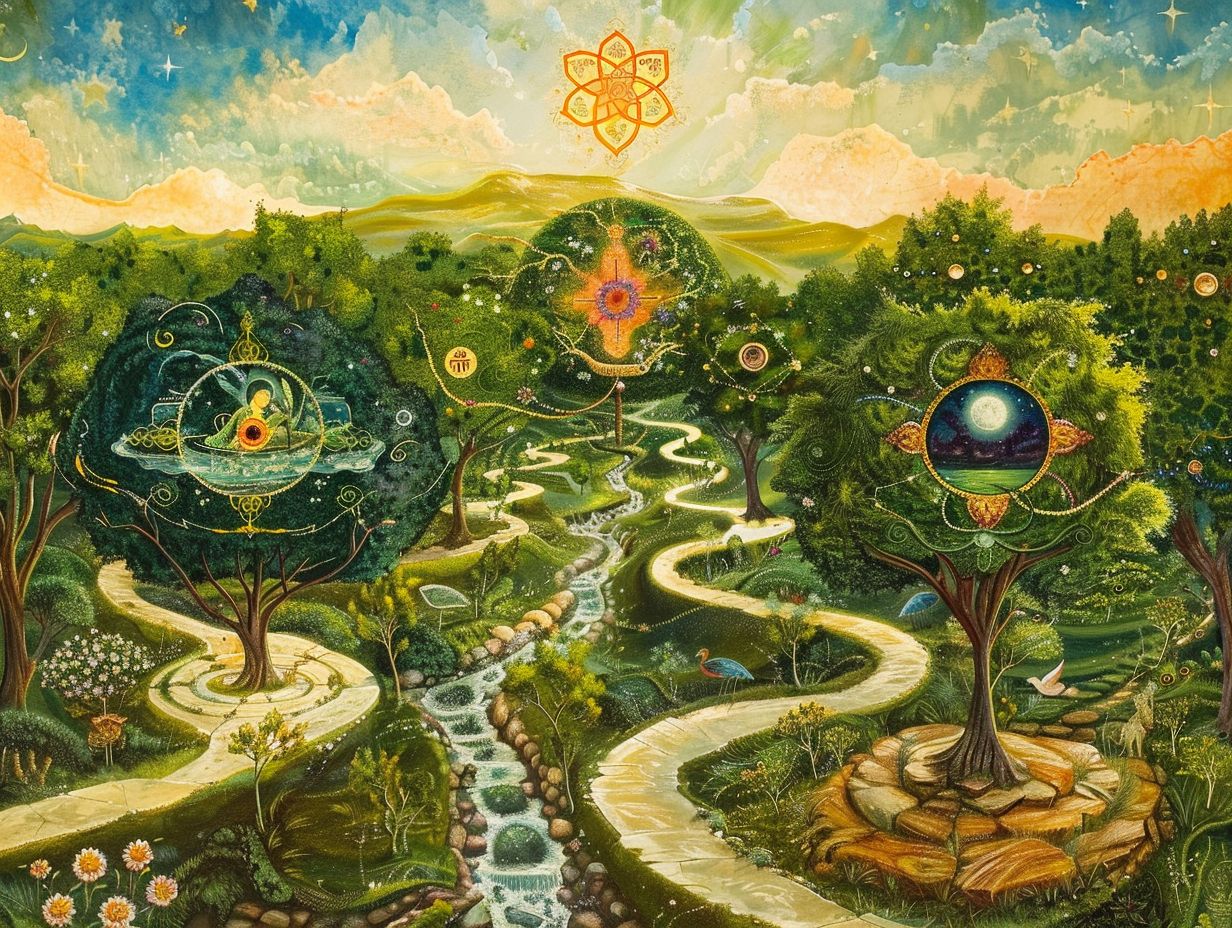The Six Schools of Astika Darshana
Astika Darshana serves as a crucial element of Hindu philosophy, comprising six influential schools of thought: Samkhya, Yoga, Nyaya, Vaisheshika, Mimamsa, and Vedanta.
Each of these schools presents distinct perspectives on reality, knowledge, and the essence of existence, significantly shaping the spiritual and philosophical framework of Hinduism.
This exploration delves into the key beliefs of each school, examining their similarities and differences, alongside their influence on Hindu practices.
Moreover, it addresses the criticisms that surround Astika Darshana, offering a comprehensive overview for those intrigued by these foundational teachings.
1. Samkhya

Samkhya stands as one of the most ancient philosophical systems within Indian thought, distinguished by its dualistic framework that distinguishes between consciousness (Purusha) and matter (Prakriti). This system aspires to knowledge and liberation (moksha) through a profound understanding of these two foundational realities, which are deemed essential to the nature of existence and the human experience.
The metaphysical underpinnings of Samkhya are anchored in the notion that reality consists of these two distinct principles. It highlights that while Purusha is eternal and immutable, Prakriti is dynamic and perpetually evolving. This dualism establishes the basis for its epistemological perspective, which posits knowledge as the essential path toward liberation.
In contrast to other philosophical traditions, such as Advaita Vedanta, which advocates a non-dualistic view, Samkhya contends that true understanding emerges from acknowledging the separation between the self and the material world.
Such recognition paves the way for liberation from the cycle of birth and death, emphasizing the critical role of cultivating awareness in the pursuit of freedom.
2. Yoga
Yoga, a distinguished school of Indian philosophy, places significant emphasis on the practices of meditation, ethical living, and self-realization as pathways to achieving samadhi, a state of profound meditative consciousness that allows for a direct experience of ultimate reality and alignment with dharma.
Historically anchored in ancient texts such as the Yoga Sutras of Patanjali and the Bhagavad Gita, yoga encompasses a diverse array of styles, including Hatha, Ashtanga, and Kundalini. Each style presents unique approaches to physical postures, breath control, and meditation, contributing to the richness of this ancient practice.
Though these traditions have evolved over time, they share a common belief: that true inner peace and spiritual growth arise from a harmonious balance of the mind, body, and spirit. Practitioners often immerse themselves in meditation techniques, including mindfulness and mantra recitation, which enhance their awareness.
Additionally, the ethical principles known as the Yamas and Niyamas serve as guiding stars, fostering qualities such as compassion, truthfulness, and non-attachment in their daily lives, ultimately paving the way to liberation.
3. Nyaya
Nyaya, as a distinguished school of Indian philosophy, centers its discourse on logical reasoning and epistemological inquiry. It employs methodologies such as inference and perception to validate knowledge and tackle profound questions regarding truth and reality through systematic critical thinking and argumentation.
This philosophical framework underscores the significance of both direct experience and logical deduction in the pursuit of understanding. Proponents of Nyaya meticulously dissect concepts, utilizing rigorous analysis to differentiate between valid and invalid reasoning, thereby enriching their discussions on knowledge.
The influence of Nyaya transcends the realm of logic, delving deeply into ethical considerations and scrutinizing how reasoning can inform moral judgments. By cultivating an environment of analytical rigor, Nyaya contributes to a more nuanced dialogue on the nature of ethics, ultimately shaping approaches to moral philosophy through its distinctive methodologies.
4. Vaisheshika
Vaisheshika, a distinguished classical school of Indian philosophy, presents an ontology that revolves around the concept of atomism. It asserts that everything in the universe is composed of indivisible particles and aims to deliver a thorough understanding of the nature of reality and human existence through its intricate metaphysical systems.
This distinctive atomistic theory not only challenges the conventional monistic perspectives but also intriguingly intersects with other philosophical frameworks such as Samkhya and Nyaya. These systems together delve into the essence of existence, each contributing its unique insights. By emphasizing the significance of these minute, indivisible entities, Vaisheshika elucidates how various material substances interact and amalgamate to create the complex structures observed in the physical world.
The implications of such philosophical thought extend far beyond mere metaphysical speculation; they prompt a profound exploration of the relationship between consciousness and materiality. This confluence of ideas fosters meaningful dialogue among diverse philosophical traditions, thereby enriching the collective understanding of reality.
5. Mimamsa

Mimamsa, a prominent school of Indian philosophy, underscores the significance of Vedic scriptures and ritualism, placing a strong emphasis on the interpretation of sacred texts and the ethical implications of performing rituals. This framework serves as a means for individuals to comprehend their dharma and attain spiritual liberation.
The tradition is elegantly divided into two principal branches: Purva Mimamsa and Uttar Mimamsa. Purva Mimamsa focuses intently on the rituals delineated in the Vedas, asserting that the correct execution of these rituals is crucial for achieving desired outcomes and fulfilling one’s responsibilities. Conversely, Uttar Mimamsa, commonly referred to as Vedanta, redirects attention toward philosophical inquiry, looking into metaphysical principles and the nature of reality.
This duality within Mimamsa not only enhances the understanding of ethics in ritualistic practices but also profoundly influences various Indian spiritual traditions. By intertwining action with philosophical contemplation, it offers practitioners valuable guidance on their journey toward knowledge and liberation.
6. Vedanta
Vedanta, an esteemed school of Indian philosophy, delves into the intricate concepts of non-dualism and dualism through its two primary interpretations: Advaita and Dvaita. These interpretations rigorously examine the relationship between the ultimate reality, known as Brahman, and the individual soul, referred to as Atman, while offering a profound framework for spiritual wisdom and self-realization.
These philosophies present distinct perspectives on the nature of the universe and the human experience. Advaita, or non-dualism, asserts that the individual soul is intrinsically the same as Brahman, suggesting that the perceived differences in the world are mere illusions. Conversely, Dvaita, or dualism, highlights the distinction between the divine and the individual, advocating for a relationship akin to that of a devotee and a deity.
These differing views significantly shape ethical considerations and inform various meditation practices. For instance, adherents of Advaita may concentrate on self-inquiry, striving to dissolve the ego, while those aligned with Dvaita often engage in devotion and surrender as essential elements of their spiritual journey. Each path offers unique advantages in their approaches to consciousness and ethical living.
What Is Astika Darshana and Its Importance in Hinduism?
Astika Darshana refers to the orthodox schools of Indian philosophy that accept the authority of the Vedas, playing a pivotal role in shaping both the spiritual evolution and cultural influence of Hinduism. This rich tapestry of philosophical discourse addresses fundamental existential questions, ethics, and the nature of reality through ancient texts and traditions.
These schools, which encompass prominent thought systems such as Vedanta, Samkhya, and Mimamsa, do not merely uphold the significance of Vedic knowledge; they also engage with profound concepts including dualism and non-dualism, the essence of the self, and the intricate interplay between karma and dharma.
Each school contributes its own unique perspectives, fostering a deeper understanding of life’s purpose and ethical living. This, in turn, paves the way for modern interpretations of spirituality that resonate with contemporary seekers.
Historically, Astika Darshana has evolved through dialogues with various thinkers and movements, enriching the philosophical landscape and offering valuable insights that continue to inspire ethical frameworks and spiritual practices to this day.
What Are the Key Beliefs of Each School?
Each school of Indian philosophy Samkhya, Yoga, Nyaya, Vaisheshika, Mimamsa, and Vedanta offers a distinctive array of beliefs that collectively enrich the diverse landscape of philosophical inquiry. These traditions engage with fundamental questions surrounding existence, knowledge, and ethics.
Not only do they explore metaphysical concepts such as the nature of reality and the self, but they also engage in epistemology, scrutinizing the sources and limits of knowledge. For example, Samkhya adopts a dualistic approach, positing that consciousness and matter exist independently, while Yoga advocates for a practical methodology aimed at achieving higher states of awareness and self-realization.
Conversely, Nyaya places a strong emphasis on logical reasoning and the criteria for valid knowledge, thereby establishing a foundational understanding of epistemic principles. Each school also embodies unique ethical frameworks; Mimamsa underscores the significance of duty and ritual, whereas Vedanta champions the ultimate pursuit of unity with the cosmic principle.
Through these varied perspectives, Indian philosophy significantly contributes to the global discourse on existence, understanding, and moral conduct.
How Do These Schools Differ from Each Other?

The diverse schools of Indian philosophy, such as the dualism of Samkhya, the practical orientation of Yoga, the logical rigor of Nyaya, the atomism of Vaisheshika, the ritualistic focus of Mimamsa, and the non-dual explorations of Vedanta, collectively illustrate the rich tapestry of thought inherent in Indian philosophical systems.
These varied doctrines delve into foundational questions of existence and morality through uniquely distinct lenses. For example, Samkhya delineates a cosmos divided into purusha (consciousness) and prakriti (matter), framing its ethical considerations around the necessity of liberation from material entanglements. In contrast, the Yoga school prioritizes experiential practices, showcasing its dedication to personal transformation as a pathway to ethical development.
Nyaya, with its stringent logical methodology, champions clarity and precision in argumentation, emphasizing the critical role of sound reasoning in moral judgments. Conversely, Mimamsa asserts that rituals are integral to human life, positing that ethical living is intimately connected to the proper performance of these rites.
Notably, Vedanta introduces a profound departure from these perspectives by asserting that all distinctions are ultimately illusory, urging individuals to recognize their intrinsic oneness with the universe. This perspective invites a reevaluation of ethics and reality, significantly reshaping one’s understanding of both.
What Are the Similarities Among the Schools?
Despite their distinct characteristics, the schools of Indian philosophy exhibit a remarkable number of similarities, united by a common aspiration for spiritual liberation (moksha), ethical considerations, and an earnest inquiry into the nature of reality and human existence.
These overarching themes construct a compelling framework for grasping the diverse yet interconnected philosophies that have flourished over the centuries. Each tradition presents its unique perspectives, yet they ultimately converge on the essential belief that the attainment of liberation is vital for human fulfillment.
Ethical principles such as ahimsa (non-violence) and satya (truthfulness) are rigorously analyzed across various schools, reflecting a shared dedication to moral living. This collective pursuit of existential understanding not only enriches individual spiritual practices but also cultivates a profound communal bond, enabling practitioners to engage thoughtfully with the teachings and insights that arise from these philosophical discussions.
How Do These Schools Influence Hindu Philosophy and Practices?
The influence of various philosophical schools on Hindu philosophy and practices is undeniably profound, intricately shaping spiritual beliefs, ethical frameworks, and rituals that guide practitioners in their pursuit of knowledge, self-realization, and a deeper understanding of their place in the universe.
Each school contributes unique perspectives that resonate with different facets of contemporary spirituality, creating a rich tapestry of approaches to meditation and ethical living. For instance, the Vedanta school emphasizes the pursuit of knowledge through inquiry and reflection, guiding individuals toward a more comprehensive understanding of their spiritual journey. In contrast, the Yoga school advocates for practices that intertwine physical postures and meditation, promoting a holistic approach to well-being.
These philosophies not only inform personal rituals but also shape community practices, encouraging collective participation in festivals and traditional ceremonies. This vibrant engagement ensures that the essence of Hindu spirituality continues to flourish in modern times.
What Are the Criticisms of Astika Darshana?
Astika Darshana, while a cornerstone of Hindu philosophy, is not without its criticisms concerning its adherence to Vedic authority, the epistemic validity of its assertions, and its nuanced positions on theism and atheism. These aspects frequently generate lively scholarly debates within the sphere of philosophical inquiry.
Critics contend that its profound dependence on scripture may confine its capacity to engage with contemporary philosophical frameworks, potentially stifling innovation and critical thought. Some philosophers raise questions about whether the rigid structures inherent in Astika Darshana inhibit certain epistemological advancements or adaptations that could prove advantageous in today’s context.
This ongoing tension fuels dynamic discussions among academics and spiritual practitioners alike, as they explore the broader implications of these philosophical positions. Engaging with these critiques paves the way for re-evaluating traditional paradigms, fostering a more comprehensive understanding of spirituality and ethics in a modern milieu.
Frequently Asked Questions

What are the Six Schools of Astika Darshana?
The Six Schools of Astika Darshana are six major philosophical schools of ancient India that accept the authority of the Vedas and believe in the existence of a supreme being.
What are the main beliefs of the Six Schools of Astika Darshana?
The Six Schools of Astika Darshana share the belief in the existence of a supreme being, the concept of karma and reincarnation, and the importance of rituals and sacrifices in achieving a better afterlife.
What are the six schools and their founders?
The six schools are Samkhya, Yoga, Nyaya, Vaisheshika, Mimamsa, and Vedanta. Their founders are Kapila, Patanjali, Gautama, Kanada, Jaimini, and Badarayana respectively.
How do the Six Schools of Astika Darshana differ from each other?
The schools differ in their interpretations of the Vedas, their beliefs about the nature of reality and the self, and their methods of attaining liberation from the cycle of rebirth.
Which school is considered the most influential and why?
Vedanta is considered the most influential among the Six Schools of Astika Darshana because of its emphasis on the spiritual aspect of the Vedas and its concept of non-dualism.
Are all the Six Schools of Astika Darshana still practiced today?
No, only the Vedanta and Yoga schools are still actively practiced today. However, the principles and teachings of the other schools have influenced various modern Hindu philosophical and religious movements.
